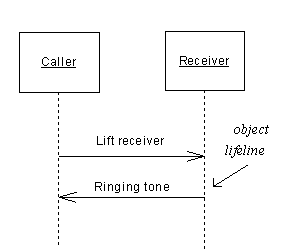At the conceptual level, an object is an element defined as being part of the system described. It represents an object that has not yet been instantiated because the classes are not yet clearly defined at this stage.
If you need to go further with the implementation of your model, the object that has emerged during analysis will probably turn into an instance of a defined class. In this case, an object is considered an instance of a class.
Three possible situations can be represented:
An object can be created in the following diagrams:
The object shares the same concept in the object, sequence and communication diagrams. It can either be created in the diagram type you need, or dragged from a diagram type and dropped into another diagram type.
Defining Multiples
A multiple defines a set of instances. It is a graphical representation of an object that represents several instances, however a multiple can only hold one set of attributes even if it represents several instances. An object can communicate with another object that is a multiple. This feature is mainly used in the communication diagram but can also be used in the object diagram.
A clerk handles a list of documents: it is the list of documents that represents a multiple object.
When the Multiple check box is selected in the object property sheet, a specific symbol (two superposed rectangles) is displayed.

Objects in an Object Diagram
In the object diagram, an object instance of a class can display the values of attributes defined on the class. When the class is deleted, the associated objects are not deleted.
Objects in a Communication Diagram
In a communication diagram, an object is an instance of a class. It can be persistent or transient: persistent is the situation of an object that continues to exist after the process that created it has finished, and transient is the situation of an object that stops to exist when the process that created it finishes.
The name of the object is displayed underlined. The Underline character traditionally indicates that an element is an instance of another element.

Objects in a Sequence Diagram
In the sequence diagram, an object has a lifeline: it is the dashed vertical line under the object symbol. Time always proceeds down the page. The object lifeline indicates the period during which an object exists. You cannot separate an object and its lifeline.
If the object is created or destroyed during the period of time shown on the diagram, then its lifeline starts or stops at the corresponding point.
Objects appear at the top of the diagram. They exchange messages between them.
An object that exists when a transaction, or message starts, is shown at the top of the diagram, above the first message arrow. The lifeline of an object that still exists when the transaction is over, continues beyond the final message arrow.
